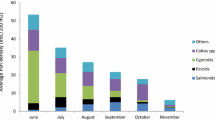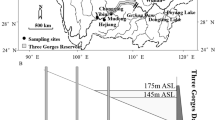Abstract
The Tamar estuary is a Special Area of Conservation (SAC) under the EU Habitats and Species Directive and a Special Protection Area under the Wild Birds Directive (1979). The lower Tamar is also the site of the Devonport naval dockyard which requires annual maintenance dredging, as well as occasional capital dredging for new installations. The main objective of this study was to investigate whether there is any evidence of significant temporal changes in key species (intertidal macrofauna, fishes, birds) and habitats (intertidal mudflats and saltmarsh) that could be related to dredging activities in the lower Tamar. Other physical variables, such as Tamar river flow and the North Atlantic Oscillation (NAO) index, representing potential drivers of changes in the abundance of biota, were also examined. Spatial and temporal changes in the abundance of intertidal macrofauna (between 1939 and 2000) were analysed but there was insufficient comparable data to enable us to draw any conclusions about long-term changes in the Tamar estuary. Commercially and ecologically important fish species (salmon and sea trout) showed a steady decline in numbers caught in the Tamar since the 1970’s. There was a significant correlation between the number of salmon caught by rod and the Tamar river flow. The sea trout abundance was significantly negatively correlated with the NAO index, suggesting that sea trout may be adversely affected by mild winters, which have been a feature of the late 1980’s and 1990’s. There were also significant correlations between the number of salmon caught in the Tamar and other rivers of the SW of England. Ten species of wildfowl and wader birds were analysed. There were no significant correlations between over-wintering numbers and dredging activity, but there were significant declines in teal and wigeon over 30 years. These species also showed a negative correlation with the NAO index suggesting the declines were related to the milder winters; possibly reducing their need to migrate south as far as SW England. Aerial photographs of the Tamar showed that the Egypt salt marsh, creeks and mudflat maintained a remarkably consistent structure over a period of >50 years. However, there was evidence of gradual erosion (0.23 m y−1) of the saltmarsh’s front cliff edge that may be related to sea level rise (~1.5 mm y−1 in SW England). The study concluded that there was no evidence of ecological changes related to the dredging activity in the Tamar. However, there were significant changes in salmon and sea trout catches, and the number of over-wintering teal and wigeon, over many decades and these changes appear to be related to large scale climatic events rather than anthropogenic factors within the Tamar estuary.








Similar content being viewed by others
References
Allen, J. R. L., 1993. Muddy alluvial coasts of Britain: field criteria for shoreline position and movement in the recent past Proceedings of the Geologists’ Association 104: 241–262.
Avoine, J., G. P. Allen, M. Nichols, J. C. Salomon & C. Larsonneur, 1981. Suspended-sediment transport in the Seine estuary, France: effect of man-made modifications on estuary-shelf sedimentology Marine Geology 40: 119–137.
Bakker, J. P., J. Deleeuw, K. S. Dijkema, P. C. Leendertse, H. H. T. Prins & J. Rozema, 1993. Salt marshes along the coast of the Netherlands Hydrobiologia 265: 73–95.
Bale, A. J., R. J. Uncles, A. Villena-Lincoln & J. Widdows, 2007. As assessment of the potential impact of dredging activity on the Tamar estuary over the last century: I. Bathymetric and hydrodynamic changes. Hydrobiologia 588: 83–95.
Clarke, K. R. & R. N. Gorley, 2001. PRIMER v5: User manual/tutorial. PRIMER-E Ltd, Plymouth UK. pp. 91.
Cox, R., R. A. Wadsworth & A. G. Thomson, 2003. Long-term changes in salt marsh extent affected by channel deepening in a modified estuary Continental Shelf Research 23: 1833–1846.
da Silva, J. F. & R. W. Duck, 2001. Historical changes of bottom topography and tidal amplitude in the Ria de Aveiro, Portugal––trends for future evolution Climate Research 18: 17–24.
Environment Agency, 1997. River Tamar Salmon Action Plan consultation document. Environment Agency, South West Region, Exeter, 50pp.
Erkinaro, J., F. Okland, K. Moen, E. Niemela & M. Rahaiala, 1999. Return migration of Atlantic salmon in the River Tana: role of environmental factors Journal of Fish Biology 55: 506–516.
European Union, 1997. Council Directive 97/62/EC adapting Directive 92/43/EEC on the conservation of natural habitats and of wild fauna and flora. Council of the European Union.
Forchhammer, M. C., E. Post & N. C. Stenseth, 2002. North Atlantic Oscillation timing of long- and short-distance migration Journal of Animal Ecology 71: 1002–1014.
Hughes, R. G. & O. A. L. Paramor, 2004. On the loss of saltmarshes in southeast England and methods for their restoration Journal of Applied Ecology 41: 440–448.
Hurrell, J., 1995. Decadal trends in the North Atlantic Oscillation: regional temperatures and precipitation Science 269: 676–679.
de Jonge, V. N., 2000. Importance of temporal and spatial scales in applying biological and physical process knowledge in coastal management, an example for the Ems Estuary Continental Shelf Research 20: 1655–1686.
de Jonge, V. N. & D. J. de Jong, 2002. ‘Global change’ impact of inter-annual variation in water discharge as a driving factor to dredging and spoil disposal in the river Rhine system and of turbidity in the Wadden Sea Estuarine Coastal and Shelf Science 55: 969–991.
Jonzen, N., A. Hedenstrom, C. Hjort, A. Lindstrom, P. Lundberg & A. Andersson, 2002. Climate patterns and the stochastic dynamics of migratory birds Oikos 97: 329–336.
Lane, A., 2004. Bathymetric evolution of the Mersey Estuary, UK, 1906–1997: causes and effects Estuarine Coastal and Shelf Science 59: 249–263.
Lewis, M. A., D. E. Weber, R. S. Stanley & J. C. Moore, 2001. Dredging impact on an urbanized Florida bayou: effects on benthos and algal-periphyton Environmental Pollution 115: 161–171.
Potts, W. T. W. & A. J. C. Malloch, 1991. River flow, Atlantic salmon (Salmo salar L.) movement and rod catch in the Aberdeen Dee Journal of Fish Biology 39: 755–764.
Sims, D. W., V. J. Wearmouth, M. J. Genner, A. J. Southward & S. J. Hawkins, 2004. Low-temperature-driven early spawning of a temperate marine fish Journal of Animal Ecology 73: 333–341.
Spooner, G. M. & H. B. Moore, 1940. The ecology of the Tamar estuary. VI. An account of the macrofauna of the intertidal muds Journal of the marine biological Association of the U.K. 24: 283–330.
Thomas, C. G., J. R. Spearman & M. J. Turnbull, 2002. Historical morphological change in the Mersey Estuary Continental Shelf Research 22: 1775–1794.
van der Wal, D., K. Pye & A. Neal, 2002. Long-term morphological change in the Ribble Estuary, northwest England Marine Geology 189: 249–266.
Warwick, R. M., J. D. Goss-Custard, R. Kirby, C. L. George, N. D. Pope & A. A. Rowden, 1991. Static and dynamic environmental factors determining the community structure of estuarine macrobenthos in SW Britain: Why is the Severn Estuary different? Journal of Applied Ecology 28: 329–345.
Watson, P. G., R. J. Clifton, J. T. Davey, P. E. Frickers & A. W. Morris, 1995. Sediment-water contaminant exchange. National Rivers Authority Report, Bristol, 185pp.
Acknowledgements
This work was jointly funded by the Tamar Estuaries Consultative Forum and the NERC Estuaries and Coastal Function and Health programme of the PML. Fish count data was supplied by the Environment Agency. Bird count data were supplied by the Wetland Bird Survey (WeBS), a joint scheme of the Brtitish Trust for Ornithology, The Wildfowl & Wetlands Trust, Royal Society for the Protection of Birds and Joint Nature Conservation Committee.
Author information
Authors and Affiliations
Corresponding author
Rights and permissions
About this article
Cite this article
Widdows, J., Bale, A.J., Brinsley, M.D. et al. An assessment of the potential impact of dredging activity on the Tamar Estuary over the last century: II. Ecological changes and potential drivers. Hydrobiologia 588, 97–108 (2007). https://doi.org/10.1007/s10750-007-0655-0
Issue Date:
DOI: https://doi.org/10.1007/s10750-007-0655-0




